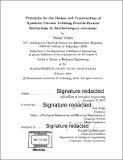Principles for the design and construction of synthetic circuits utilizing protein-protein interactions in Saccharomyces cerevisiae
Author(s)
Mishra, Deepak, Sc. D. Massachusetts Institute of Technology
DownloadFull printable version (22.99Mb)
Other Contributors
Massachusetts Institute of Technology. Department of Biological Engineering.
Advisor
Ron vveiss.
Terms of use
Metadata
Show full item recordAbstract
Within synthetic biology, significant progress in creating networks using transcriptional and translational control has been made, but a network comprised solely of protein-protein interactions has not yet been built. To realize this goal, new design rules for assembling and connecting protein devices into circuits are required. In this thesis, a framework for rapid assembly and delivery of genetic networks in Saccharomyces cerevisiae is described. Utilizing this scheme, design principles of modular chimeric proteins, engineered pathway convergence, and phosphorylated activated localization are developed and subsequently applied to create phosphoin/phospho-out composable protein devices in yeast. The devices implement BUFFER, NOT and OR logical operations and collectively form a functionally complete set whereas multiple instances of the devices can be connected to implement any logical expression. Furthermore, bridge devices to interface small molecule sensors and transcriptional networks with protein devices are created. To illustrate composability, two systems are engineered in yeast, the first of which interfaces a phosphorylation load driver within flanking transcriptional regulatory modules to mitigate retroactivity, exemplifying time-scale separation as a means of realizing functional modularity in biological networks. The second system, a fast bistable toggle switch, is the first synthetic network based solely on protein interactions and can be interfaced endogenously to allow controllable abrogation of yeast budding. Work in this thesis provides a set of useful design principles for engineering protein networks in eukaryotes and may improve understanding of natural signaling motifs, allow modulation of existing networks, or foster new synthetic biology applications.
Description
Thesis: Sc. D., Massachusetts Institute of Technology, Department of Biological Engineering, 2016. Cataloged from PDF version of thesis. Includes bibliographical references (pages 213-223).
Date issued
2016Department
Massachusetts Institute of Technology. Department of Biological EngineeringPublisher
Massachusetts Institute of Technology
Keywords
Biological Engineering.